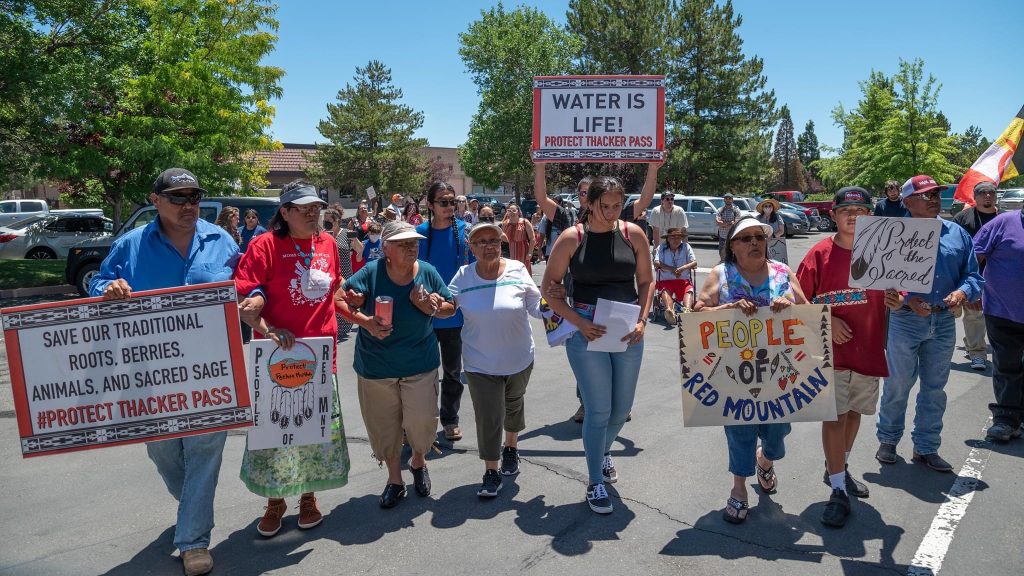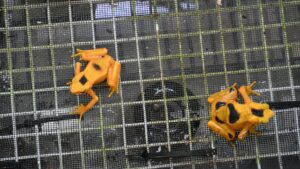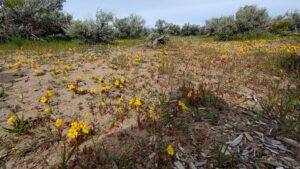
Many environmentalists support the idea of switching to electric vehicles to reduce use of fossil fuels. Those vehicles rely extensively on extracting more and more lithium to produce their batteries. To get in on this “gold rush” for lithium, a Canadian company has proposed a lithium mine in northern Nevada. But the plan has nearby Fort McDermitt Paiute and Shoshone tribal members and environmentalists concerned it will drain the groundwater, contaminate the environment and desecrate sacred ancestral lands.
After a 10-year process, the Thacker Pass project was officially given the green light to go forward by the federal government in January, during the final days of the Trump administration. However, Lithium Americas’ original plans to start digging on site on June 23 have been put on hold. A federal judge will evaluate claims that the former Trump administration approved the project that opponents say could threaten the endangered Lahontan Cutthroat Trout, Greater Sage Grouse, and other wildlife.
According to the Environmental Impact statement (EIS), a required federal evaluation of any proposed project on public lands, the Thacker Pass Lithium Mine Project would be located in a sea of sagebrush within an extinct supervolcano along the Nevada-Oregon border in northern Humboldt County, Nevada. This location is approximately 62 miles north-northwest of Winnemucca and approximately 50 miles southwest via gravel road from the Fort McDermitt Indian Reservation.
The company seeking to develop the mine is called Lithium Nevada; it has an office in Reno and is a subsidiary of the Canada-based mining company Lithium Americas. The proposed open-pit mine will encompass 17,933 acres of land managed by the Bureau of Land Management, according to the EIS. The same document states that within that area the mine itself would span approximately nine square miles and contain pits reaching 370 feet deep.
Pit Mining Could Lower Water Table
An estimated 3,224 gallons of groundwater will be pumped each minute to help the mine produce 66,000 tons a year of battery-grade lithium carbonate over its estimated 41-year mine life. That’s about an Olympic pool’s worth of water pumped every three and a half hours. The mine plan proposes several possible water sources, including wells and nearby creeks. Materials shared by Lithium Nevada indicate the company would monitor groundwater levels and mitigate if necessary. The company declined an on-the-record phone interview and didn’t answer specific follow-up questions posed via email.
The availability of water in this region is already limited according to John Hadder, the director of the nonprofit environmental justice organization Great Basin Research Watch.
“They’re obviously going to use water in the area, and it’s an area where water use is already very tight,” said Hadder. “Both of the basins on both sides of Thacker Pass are what we call fully allocated, so any additional water usage is a concern.”
The basin’s water rights are owned by nearby ranches, and in order to get permission to pump, the mining companies need to acquire existing water rights by purchasing ranches and water rights associated with those ranches. Lithium America currently owns one nearby ranch and the associated water rights.
Some farmers and ranchers from around the area are concerned if the mine acquires existing water rights, it could deplete the groundwater underneath their land.
“A lot of mines have to do something called de-watering because the ore is significantly below the water table. The reason for that is that if you’re trying to excavate a mine and water keeps seeping into the operation, that’s going to be a problem,” said Hadder.
Mining operations do this by drilling wells around the perimeter of their expected pit, and sometimes in the pit itself, and then begin pumping water out to lower the water table artificially.
According to the EIS report, to keep the pit and the operations dry, groundwater is pumped out of the earth but not consumptively used. This means it will ultimately be returned to the earth, though in this proposed mine it would be disposed in a different location. One concern caused by pumping water for the mine is that it could potentially reduce or possibly eliminate springs over time, said Hadder.
“That does create large effects on springs in the area during the period of pumping and also afterwards, because it can take a long time for the area to recover from that much massive pumping,” Hadder said.
Nearby Rancher Concerned About Water Use
Edward Bartell is a long-time Nevada cattle rancher based in the Great Basin located near the Thacker Project. He’s also concerned about the water usage from the proposed open-pit mine as well as potential impact on wildlife. He currently has a lawsuit pending against Lithium America. Although he says he’s not able to comment on the litigation, he’s concerned the mine could have negative consequences since the pumping would create drawdowns in the groundwater underneath his property.
“If the water levels drop anywhere near the amount that the company is indicating, it will devastate the vegetation there,” Bartell said.
Bartell explains that water is already scarce in the region, and the Quinn River Valley doesn’t flow most years. He’s worried mining will exacerbate the problem.
“There are streams and springs out there where you have a relatively tiny amount of water that is used to supply wildlife and stock and so any minor drawdown in the water table will have the potential of impacting that,” Bartell explained.
The EIS analysis also reported that due to the uncertainty of the actual groundwater elevations in the area, it’s unclear how the springs could be impacted:
“Depending on the severity, a reduction in baseflow could result in a spring drying up. Springs affected by drawdown and located in areas where the drawdown is predicted to persist over the model simulated post-closure period would not likely recover.”
Chemical Concerns
Along with other environmental advocates, John Hadder of the Great Basin Research Watch is also concerned about the potential for leaching of metals into groundwater, such as arsenic and antimony. These chemicals are naturally occuring in deep rocks that are dug up in the pit mining process and ultimately returned during the backfill. Once these materials are brought closer to the surface, the toxins can leach into surface and groundwater.
“So that waste rock, because the material has been broken-up and exposes a lot more surfaces underground in the water, which allows the mobilization, as we call it, the movement of various metals and other elements that would be considered toxic,” Hadder said.
Tribal Community Concerns
In addition to concerns about water usage and contamination, Indigenous peoples have relied on Peehee Mu’huh or “Thacker Pass,” for generations as a gathering place and using the natural resources there for traditional foods and medicines. This includes plants like Toza root, Sagebrush and Ghostbuster, which was used to make special teas during the COVID-19 pandemic.
Fort McDermitt Paiute and Shoshone Tribal Chairwoman Maxine Redstar said that the construction of the open-pit mine could have unintended consequences that could impact the tribe’s way of life and desecrate their ancestral homelands.
“When it comes to the water, you start depleting that water, you start contaminating the water, everything’s going to go away because life is dependent on that water,” said Chairwoman Redstar.
Chairwoman Redstar has used her leadership role to advocate for her people.
“Green energy is supposed to be safe,” said Chairwoman Redstar. “I know it’s hard to believe that that’s something safe and you’re dealing with all of these contaminants. So, you have to hang on to what little you have, because if you lose your tradition, your culture goes right out the window with it.”
In April, in response to a petition from tribal members, the Fort McDermitt Paiute and Shoshone tribal council voted unanimously to withdraw the tribe from an earlier agreement with Lithium America under which the tribe would have consulted with the mining company.
Fort McDermitt Paiute and Shoshone tribal member, Daranda Hinkey, moved back home to the Fort McDermitt reservation in 2020 after obtaining her bachelor’s degree in Environmental Science and Policy from Southern Oregon University.
Hinkey caught word of the proposed lithium mine and began to ask questions about why she, her family and the greater public were not informed on what was going on. She learned that consultations took place during the pandemic when the tribe was on lockdown and could not participate in conversations about the project. For her, there’s still so many unanswered concerns.
“When Thacker Pass is turned into a lithium mine, what is that going to mean? It’s not going to be Peehee Mu’huh anymore because those cultural sites, those spiritual sites, they’re all taken away,” said Hinkey. “I don’t think that a lot of people see it as that. I really hope that Thacker Pass isn’t a lithium mine, because there’s no way to replace those things.”
Others share her same concerns. After federal land managers approved the mine in January, members of tribes from across the Great Basin began visiting the proposed site. Protesters banded together and set up an encampment called Protect Thacker Pass.
In order to have their voices heard, Indigeneous protesters formed a group called Atsa koodakuh wyh Nuwu, which translates to “People of Red Mountain.” People of Red Mountain is a group of elders, middle-aged people, and youth tribal descendants from Fort McDermitt who are collectively standing up against this lithium mining project, as well as other proposed mining projects around the Fort McDermitt reservation.
“We thought it would be a really good idea to have this community voice to help us in the future,” said Hinkey. “We’re seeing destruction of land and possible pollution and drought of water.”
In May 2021, People of Red Mountain wrote a public statement opposing the Thacker Pass mine and explaining the cultural significance the land holds.
“In addition to environmental concerns, Thacker Pass is sacred to our people,” they wrote. “Thacker Pass is a spiritually powerful place blessed by the presence of our ancestors, other spirits, and golden eagles – who we consider to be directly connected to the Creator.”
The Paiute word for Thacker Pass is Peehee Mu’huh, which translates to “rotten moon.” According to oral history, the area was so named because of a massacre that occurred in the mid-1800s when cavalry came in and slaughtered elders, women, and children while the men were away on a hunt. The hunters returned to find their loved ones murdered, unburied, and their rotting entrails scattered across the sagebrush in the shape of a crescent moon.
In addition, People of Red Mountain describe how building a lithium mine over this massacre site in Peehee Mu’huh would be the equivalent to building a mine over Pearl Harbor. Indigneous peoples say Americans would never desecrate their cemeteries and ask that their sacred sites be afforded the same respect.
It is unclear whether this project will move forward due to the pending court filings and the concerns of impacts to wildlife and the environment.





